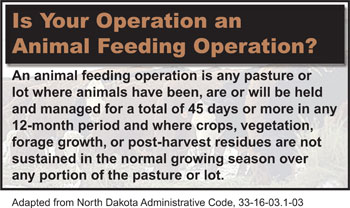



BeefTalk: Most Cow-calf Producers Are Animal-feeding Operations
By Kris Ringwall, Beef Specialist, NDSU Extension Service.Change, a force that all beef producers, and essentially all those who are caretakers of animals, will need to be prepared to face, is present. A major focus of change is the concept of animal-feeding operations within the livestock industry.
 The point now is that more than likely you are an animal-feeding operation if you are in the beef business or any livestock business. Producers will need to become more familiar with what that means and its potential impact on the livestock operation. Forces of change are not unique in agriculture and have been known to come with significant impact.
The point now is that more than likely you are an animal-feeding operation if you are in the beef business or any livestock business. Producers will need to become more familiar with what that means and its potential impact on the livestock operation. Forces of change are not unique in agriculture and have been known to come with significant impact. For one, weather will drive production and producers even when predictability is difficult. Are the next 10 years going to be wet or dry? We will know in 10 years.
Those who have been involved with agriculture have learned to live with risk and the unpredictable nature of the business. Change is not new, nor is the reason for that change always welcome. However, through time, acceptance of change tends to keep operations in business.
The current issues with the environment will fall in many of the same camps and conversations. The North Dakota State Department of Health is authorized, as well as challenged, to provide and administer those activities within the state that deal with the control of pollution from animal-feeding operations.
Perhaps the most poignant point is that animal-feeding operations are defined within the Administrative Code of North Dakota as meaning “a lot or facility, other than an aquatic animal production facility, where the following conditions are met: a. Animals, other than aquatic animals, have been, are, or will be stabled or confined and fed or maintained for a total of 45 days or more in any 12-month period; and b. Crops, vegetation, forage growth, or post-harvest residues are not sustained in the normal growing season over any portion of the lot or facility.”
For most cattle producers, this definition means you are more than likely an animal-feeding operation. Now that is not bad, but it is important for future plans to realize that discussions about animal-feeding operations involve more than what many regard as feedlots. Animal-feeding discussions must involve cow-calf producers, as well as all animal caretakers.
Producers are responsible to check on regulations in North Dakota and every state in the union because different states may have different rules. For now, the designation only is a term, but sometimes a term that is redefined depending on type and size of operation.
It is important for all cattle producers - all livestock producers - to start becoming acquainted with the process used to determine how your individual operation is viewed in terms of significance. One good way to become more knowledgeable with the questions concerning these issues is to contact your local Extension Service agent or stockman’s association and start asking questions.
A good publication to start the process is “Assessment Tool for New and Existing Animal-feeding Operations (NM-1284)” published by the North Dakota State University Extension Service. By walking through the refined and simple questions, an operation can get a better feel for the impact that many of these changing laws will have on a livestock operation.
Fear still can be a driver, but avoidance accomplishes nothing. For the vast majority of producers, the new regulations are quite manageable. In some cases, it only means a slight modification in production practices. However, there are those who will have to deal with some very expensive and difficult decisions.
Knowledge of the laws is important. That knowledge will be the power to enact appropriate plans. More later.
May you find all your ear tags.
Source: NDSU Extension Service - November 2006


